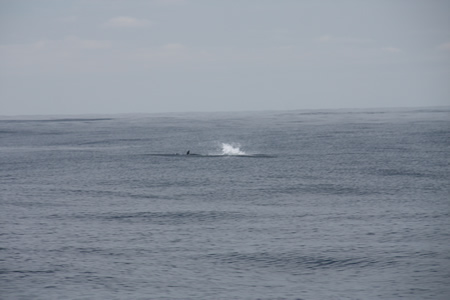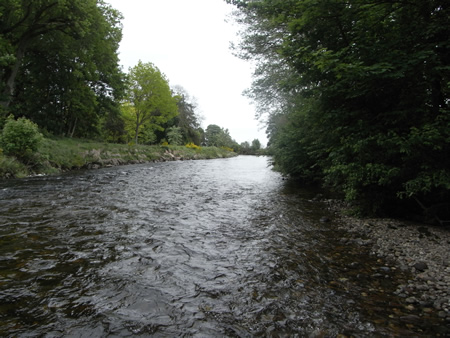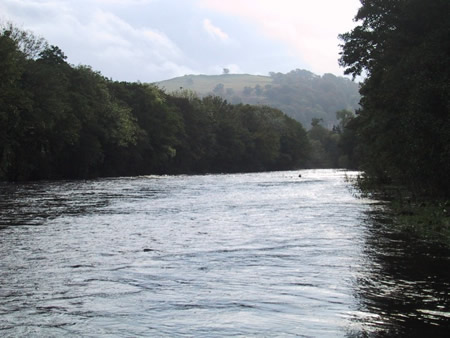The continuous wet weather has yet again played havoc with the plans of our night sea trout fishers. Most fish running the river have just kept going, but fortunately this year there have been plenty of sea trout, and we have been able to catch them after each spate. Yesterday, Wednesday 11 July, was no exception, and 4 rods capitalised on a decent run of salmon and sea trout, with six salmon to 11lbs and twelve sea trout to 3lbs caught in Finavon’s pools. The total catch for the season up to 19 July is 49 salmon and 104 sea trout. While the numbers of salmon are about average, it is encouraging to see an extended run of sea trout, with fish of good quality denoting good feeding at sea.
The bigger picture. Reports from the Scottish west coast are of an abundance of sand eels which, were it not for the damaging impacts of sea lice epizootics from salmon farms, one could expect to produce good sea trout runs in local rivers. However, I do hear encouraging signs of improvements from rivers close to where more responsible salmon farming companies are trying to reduce sea lice infestations. My personal yardstick will be the return of the River Ailort and Loch Eilt to its former reputation as one of Scotland’s top sea trout fisheries. I am in no doubt that such a transformation could occur, but that will require a different regime of salmon farming than exists at present in the quiet tidal enclave and sheltered waters of Loch Ailort itself. The removal of open cages in Loch Eilt, where salmon are reared to smolts, should also help return the loch and river to their natural state, with the result that migration of trout to sea can resume.
Milton Beat outperforms the other FCW beats. As has been the norm this season, most of the fish last week were caught on Milton Beat and, extraordinarily, on Wednesday every fish from that beat was caught in Willows. I will write a bulletin blog soon on the subject of Willows and why I think it is such a productive pool. Elsewhere, yet another 20lbs plus salmon was hooked and lost in Indies Pool after a 30 minute struggle. On other rivers, I note that there have been some tremendous catches on the Spey, with, for example, Upper Arndilly accounting for 50 salmon last week, and 35 in the first four days of this week. Another fish of 25lbs came from the Teith at Blair Drummond, and reports of big MSW salmon from other rivers, just as Jens Christian Holst, the Norwegian marine ecologist at IMR Bergen, predicted. Some grilse have also started to appear at Finavon, the condition of which is nothing to write home about.
The last three months of 2012. As we move towards the end of July, and with the last three months of the season to come, the quality of fishing at Finavon will depend on whether or not there are sufficient maturing MSW salmon and grilse returning to the coast. Of course it will also depend on whether there is enough water to bring fish into the river and avoid the coastal nets. It will be interesting to see whether the marked trend for bigger salmon continues, and whether the South Esk produces one of its occasional monsters (anything over 30lbs qualifies!). Certainly there are a good number of fish of 20lbs plus already in the river, but it is a step-up to catch a really big salmon of over 30lbs. As far as grilse are concerned, I do not expect a great abundance, and would love to be proved wrong. One or two of the grilse already caught at Finavon have been pitifully thin, probably because they have been feeding in the NE Atlantic which, in terms of prey species abundance, is patchy at best, and in some places offers only a starvation diet.
MSW fish, the Greenland ‘cornucopia’, and declining numbers of European returners. Irish research scientists studying historical records of salmon caught in the Greenland ‘distant’ fishery have discovered that the number of MSW salmon of European origin feeding in the West Greenland fjords has dropped by 75% in the last thirty years. That is worrying news, and there is now real urgency to find out why that has happened. If, as seems to be the case, European post-smolts and non-maturing 1SW fish are simply not getting to the Greenland feeding areas, there could be a range of causes, including a high level of attrition of smolts soon after they leave fresh water. The simple truth is that smaller fish are more likely to be predated than bigger ones, although there could be causes for reduced numbers, other than predation. Our outgoing smolts are of course vulnerable to the usual suspects (pisciverous birds, seals et alia) but also to invasions of climate change species such as bass and gilt head sea bream, both accomplished predators. You can imagine phalanxes of these predators ringing the estuaries in April and May just as smolts migrate. What chance would our S2 and S3 smolts have of getting to sea past such a cordon? Then there is the unknown impact of pelagic trawlers’ by-catch, where little post smolts may be mangled in the wide-mesh nets and spat out in pieces, just like putting them into a tumble dryer. We urgently need to understand what is happening to our post smolts in estuaries and along the coast.
We should count our blessings. Those of us who are involved in research and management of our wild migratory salmonids are good at giving doom-ridden prognoses on their future abundance. We read the ICES reports showing declining abundance and quality. We read the conclusions of the SALSEA project telling us that European stocks are under threat from the impacts of climate change. We listen to the wise words of the ecologists and ocean specialists who tell us that temperatures, currents, and weather patterns of our oceans are changing.
Mid Atlantic surface feeding by dolphins (picture taken by JMHA from his yacht in May 2012)
Yet, on our own ‘wee patches’, in my case Finavon Castle Water on the South Esk, we live in hope that all these depressing statements and predictions may be wrong. If you are a tenant at Upper Arndilly on Spey in the second week in July for example, with 50 salmon for your week, you could be forgiven for thinking that the scientists are giving us a lot of twaddle. At Finavon, to catch three 15lbs April salmon in spectacular, Platonic-form, condition you might think “well, we don’t have to worry, do we?. But, make no mistake, these facts will not go away: they are with us here and now as the effects of ocean warming march northwards by 23 kms each year. We all need to ‘think globally and act locally’. Never have Sir Patrick Geddes’s words been more relevant.
TA on 12/7/2012


